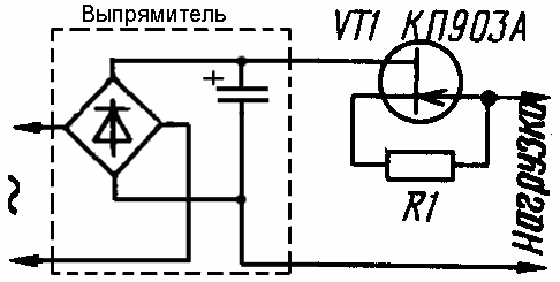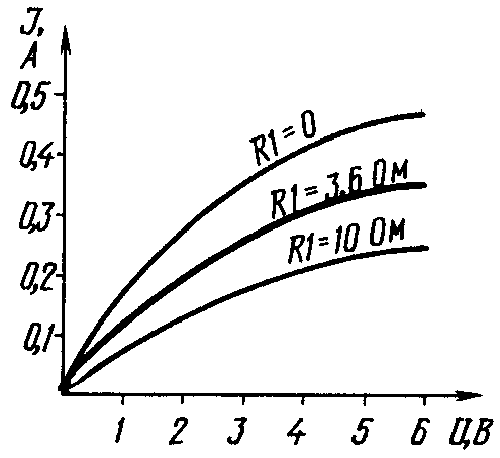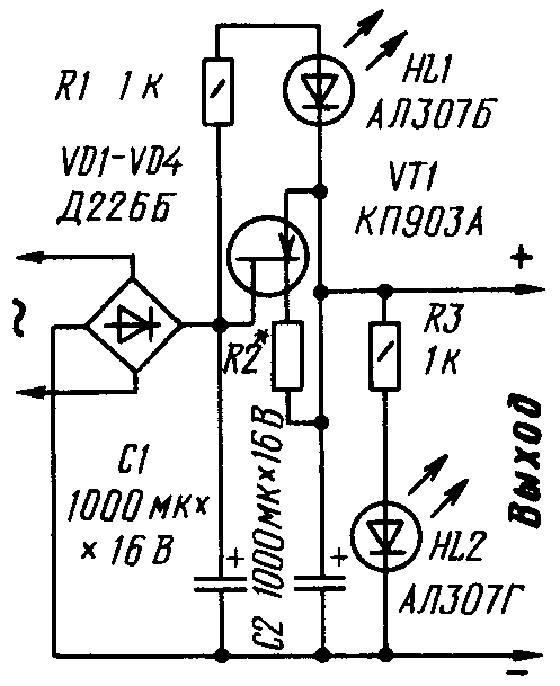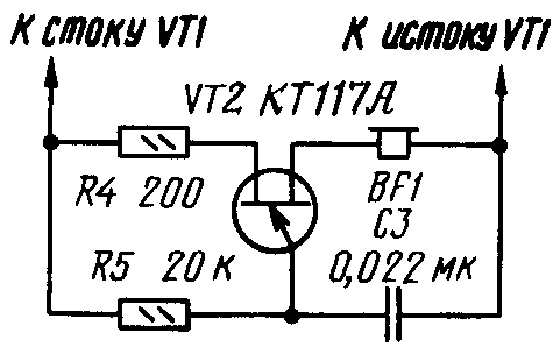To collect power structures Amateurs often use simple blocks, consisting of a step-down transformer and rectifier with capacitor filter. And, of course, in such blocks there is no protection against short-circuit in the load, although it often leads to the failure of the rectifier, and even the transformer.
To apply in such power supplies as part protection fuse is not always convenient, and, in addition, the speed he has is low.
One of the solutions to the problem of short circuit protection - inclusion in series with the load FET average power with built-in channel. The fact is that the current / voltage characteristic this transistor has an area on which the drain current does not depend on the voltage between the drain and the source. Therefore, in this region the transistor works as a stabilizer (limiter) current.

Fig. 1
The scheme of connection of the transistor to the power supply is shown in Fig. 1, and the current-voltage characteristics of the transistor for the various resistances of the resistor R1 in Fig. 2. Protection works so. If the resistance of the resistor is zero (i.e. the source is connected with the shutter), and the load consumes a current of about 0.25 A, the drop voltage FET does not exceed 1.5 In, and almost the load will be all rectified voltage. At the appearance of in the load circuit short-circuit the current through the rectifier increases dramatically and when the absence of the transistor can be several amperes. Transistor limits the short circuit current level 0,45 0,5...But whatever from the voltage drop on it. In this case, the output voltage becomes zero, and the voltage drop will occur on the field-effect transistor. Thus, in case of short circuit, the power consumed from the power source, will grow in this example, not more than twice that in most cases is quite acceptable and will not affect the "health" of parts of the block power.

Fig. 2
To reduce the short-circuit current can increase the resistance of the resistor R1. You must select a resistor to the short circuit current was approximately twice the maximum the load current.Such protection is especially useful for blocks power with RC smoothing filter - then include field-effect transistor instead of the resistor of the filter (an example is shown in Fig. 3).
Since, during the short-circuit FET falls almost all of the rectified voltage, it can be used for light or audible alarm. Here, for example, the switching circuit light alarm - Fig. 7. When the burden is OK, the led is lit HL2 green. In this case the voltage drop across the transistor is not enough for ignition of the led HL1. But should appear short circuit in the load, as the led HL2 is off, but flashes HL1 red glow.

Fig. 3
The resistor R2 is chosen depending on the desired limitations of short-circuit current on the recommendations made above.The scheme of connection of the audible alarm is given in Fig. 4. It can be connected either between the drain and the source of the transistor, or between the drain and the gate, as the led HL1.
When enough voltage detector in effect the generator AF performed on unijunction the transistor VT2, and in the head phone BF1 sound is heard.
Unijunction transistor can be CTA - CTG, phone - low-resistance (can be substituted with a dynamic head small power).

Fig. 4
It remains to add that for low loads in the power supply, you can enter the current limiter short-circuit FET CPU. When selecting transistor for other blocks should be taken into account it admissible power and the voltage of the source - drain.Of course, such automation can be administered in stable power supply, no protection against short-circuit in the load.
Author: I. Nechaev, Kursk; Publication: www.cxem.net






